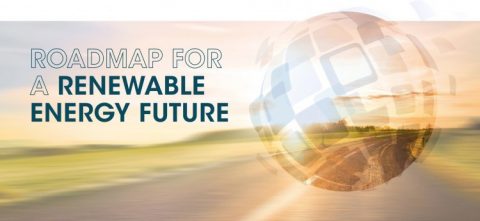
IRENA: ‘Verdubbeling duurzame energie levert 4200 miljard dollar op’
24 maart 2016 – Het aandeel hernieuwbare energie verdubbelen in 2030 is niet alleen mogelijk, het is ook goedkoper dan het niet te doen. Dat berekende het International Renewable Energy Agency (IRENA). De wereldwijde besparing is jaarlijks 4200 miljard dollar – 15 maal meer dan de benodigde investeringen in hernieuwbare energie.
Verdubbeling van het aandeel hernieuwbare energie levert miljoenen banen op, veel minder doden door luchtvervuiling en het levert economisch veel meer op dan het kost. Als de groei van hernieuwbare energie wordt gecombineerd met energiebesparing, kan het bovendien de opwarming van de aarde onder de 2 graden houden zoals het klimaatakkoord uit Parijs nastreeft.

Dat concludeert IRENA in het rapport ‘REmap: Roadmap for A Renewable Energy Future, 2016 Edition’. Daarin onderzoekt IRENA de energietransitie in 40 economieën, samen goed voor 80 procent van het energieverbruik. Het rapport, een vervolg op de editie van 2014, komt met een ‘roadmap’ naar verdubbeling van het aandeel hernieuwbare energie.
In 2014 was het aandeel hernieuwbare energie 18,4 procent. Als bestaand beleid wordt uitgevoerd, zal dat in 2030 21 procent zijn, aldus IRENA in het rapport. Met name in de elektriciteitsproductie zijn grote stappen gemaakt, maar transport en de bouw lopen achter, stelt Dolf Gielen, directeur van IRENA’s Innovation and Technology Centre.
Uit het bericht van IRENA
‘(…) While great strides have been made to increase renewables in the power sector – which is on track to generate roughly 30% of the world’s electricity by 2030 (up from 23% today) – more action is needed to increase renewables in transport (i.e electric cars) and in buildings and industry (i.e. heating and cooling) as these sectors are lagging behind.
The REmap report helps map the course the global community must run to scale up renewables in the next 14 years. Now policy makers and governments must take the required action to move to speed up the energy transition and finish the race in time. (…)’
Welke acties dat zouden moeten zijn, zet IRENA uiteen in de roadmap.
Uit de managementsamenvatting van het rapport
‘(…) Some 60% of the world’s renewable energy potential can be achieved by implementing what this roadmap calls “REmap Options”. The remaining 40% can be realised through accelerated energy efficiency along with an investment push to achieve universal energy access with renewables. Described here as the “Doubling Options”, these combine new technologies with deeper structural changes. (…)’
IRENA noemt vijf actiegebieden.
- ‘(…) Correct for market distortions to create a level playing field.
This could be achieved by introducing carbon prices to reflect the external costs of fossil fuels, as well as improving the regulatory framework for the renewable energy market. Governments also need to account for externalities related to human health and climate change in energy pricing. Risk-mitigation mechanisms will be important to mobilise investment. - Introduce greater flexibility into energy systems and accommodate the variability of key renewable energy sources. The availability of solar and wind energy is predictable, despite daily and seasonal variations. Interconnectors between national or regional grids help to balance supply and demand for power. Demand-side management, electricity storage and smart grids also strengthen the integration of variable renewables, while real-time market pricing helps to assess the value of power generation at different times. New regulatory frameworks must allow new entrants into the power market and reflect the evolving roles of utilities and consumers.
- Develop and deploy renewable heating and cooling solutions for urban development projects and industry. Cities, local governments and municipalities need to encourage the uptake of renewables and adopt efficient, centralised district systems. Sector coupling allows surplus electricity to provide heating and cooling for buildings and industry.
- Promote transport based on renewable power and biofuels. Urbanisation is occurring rapidly worldwide, and clean transport is necessary to keep cities liveable. Trams, buses, freight and passenger vehicles powered by renewable-based electricity must become the predominant forms of city transport. This can be achieved through smart city planning and the rollout of recharging and supply infrastructure. Government support is needed to commercialise advanced liquid biofuels for widespread use, especially in aviation, freight and shipping.
- Ensure the sustainable, affordable and reliable supply of bioenergy feedstocks. Bioenergy can come from agricultural and forestry residues, waste and other sustainable feedstocks. It is particularly important in applications for which no other renewable energy technology is suitable, such as high-temperature process heat in industry. Depending on the feedstock type, either markets need to be expanded or vertical integration of the fuel chain is needed to guarantee supply of reliable and affordable bioenergy products. New international trade and infrastructure policies are needed to facilitate local, regional and global trade in bioenergy commodities. (…)’
Bronnen
IRENA, 17 maart 2016: Doubling renewables can save trillions
IRENA, rapport, maart 2016: REmap: Roadmap for A Renewable Energy Future (pdf)
IRENA, maart 2016: REmap: Roadmap for A Renewable Energy Future, Executive Summary
Climate Action Programme, 21 maart 2016: Doubling renewables could save global economy $4.2trn
Afbeeldingen en video: IRENA



